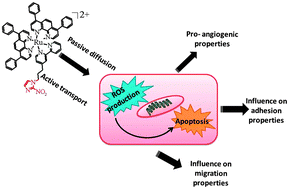The biological effect of the nitroimidazole derivative of a polypyridyl ruthenium complex on cancer and endothelial cells†
Abstract
The ruthenium polypyridyl complexes [Ru(dip)2(bpy/bpy-2-nitroIm)]2+ (dip = 4,7-diphenyl-1,10-phenanthroline, bpy = 2,2′-bipyridine, bpy-2-nitroIm = 4-[3-(2-nitro-1H-imidazol-1-yl)propyl]) were found to be ca. ten times more cytotoxic against breast cancer (4T1) and human lung adenocarcinoma epithelial cells (A549) than a well-known anticancer drug, cisplatin. Even though the Ru complexes were quite cytotoxic towards FVB mouse lung microvascular endothelial cells (MLuMEC FVB) their efflux from these non transformed cells was much more efficient than from cancer ones. Both Ru complexes accumulated in cells. The cellular uptake of both Ru complexes occurs through passive diffusion while the nitroimidazole derivative is also endocytosed. They arrest cell growth in the S-phase and induce apoptosis. Such cell response can result from activation of oxidative stress by Ru complexes. The modulation of the mRNA expression profile for genes which might be involved in metastasis and angiogenesis processes by Ru complexes was analyzed for both cancer (4T1) and endothelial (MLuMEC FVB) cells. Ru complexes appeared to have a distinct impact on cell adhesion and migration as well as they affect endothelial cell vasculature. They are not only cytotoxic but are also potentially invasive and anti-metastatic agents. This work illustrates the putative future development of polypyridyl ruthenium.


 Please wait while we load your content...
Please wait while we load your content...